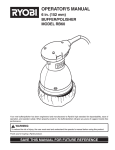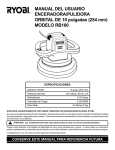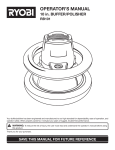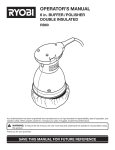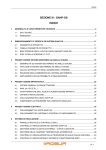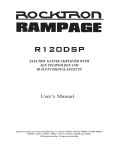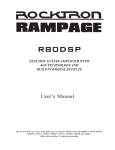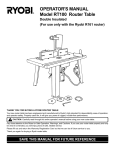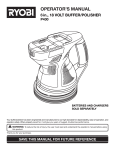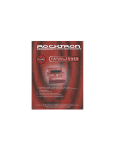Download Ryobi RB100 Operator`s manual
Transcript
OPERATOR'S MANUAL 10 in. (254 mm) ORBIT BUFFER/POLISHER MODEL RB100 SPECIFICATIONS: Orbital Diameter Rating Input No load Speed Net Weight 10 in. (254 mm) 120 Volts, 60 Hz, AC .75 Amps 3200 RPM 4.5 lbs. (2 kg) THANK YOU FOR BUYING A RYOBI BUFFER/POLISHER. Your new buffer/polisher has been engineered and manufactured to Ryobi’s high standard for dependability, ease of operation, and operator safety. Properly cared for, it will give you years of rugged, trouble-free performance. CAUTION: Carefully read through this entire operator’s manual before using your new buffer/polisher. Pay close attention to the Rules for Safe Operation, Warnings, and Cautions. If you use your buffer/polisher properly and only for what it is intended, you will enjoy years of safe, reliable service. Thank you again for buying Ryobi tools. SAVE THIS MANUAL FOR FUTURE REFERENCE TABLE OF CONTENTS ■ Table of Contents .............................................................................................................................................................2 ■ General Safety Rules .................................................................................................................................................. 3-4 ■ Specific Safety Rules And/Or Symbols ........................................................................................................................ 4-5 ■ Applications .....................................................................................................................................................................6 ■ Features ..........................................................................................................................................................................7 ■ Operation ................................................................................................................................................................... 8-10 ■ Maintenance .............................................................................................................................................................10-11 ■ Troubleshooting ............................................................................................................................................................. 11 ■ Parts Ordering / Service ................................................................................................................................................12 WARNING: WEAR YOUR SAFETY GLASSES FORESIGHT IS BETTER THAN NO SIGHT The operation of any buffer/polisher can result in foreign objects being thrown into your eyes, which can result in severe eye damage. Before beginning power tool operation, always wear safety goggles or safety glasses with side shields and a full face shield when needed. We recommend Wide Vision Safety Mask for use over eyeglasses or standard safety glasses with side shields. Always use eye protection which is marked to comply with ANSI Z87.1. WARNING: To minimize the risk of eye injury, always use eye protection which is marked to comply with ANSI Z87.1. Always use the pad that accompanied the buffer/polisher. Comply with all operating instructions, warnings, General and Specific Safety Rules and cautions found in this manual. Failure to heed these warnings can result in serious personal injury. For more information on ANSI Standards, contact the American National Standards Institute, Inc., 11 West 42nd Street, 13th Floor, New York, NY 10036, or visit www.ansi.org. Look for this symbol to point out important safety precautions. It means attention!!! Your safety is involved. Page 2 GENERAL SAFETY RULES Personal Safety WARNING: ■ Read and understand all instructions. Failure to follow all instructions listed below may result in electric shock, fire and/or serious personal injury. SAVE THESE INSTRUCTIONS Work Area ■ ■ ■ ■ Keep your work area clean and well lit. Cluttered benches and dark areas invite accidents. Do not operate power tools in explosive atmospheres such as in the presence of flammable liquids, gases, or dust. Power tools may create sparks which may ignite the dust or fumes. Keep bystanders, children, and visitors away while operating a power tool. Distractions can cause you to lose control. Electrical Safety ■ ■ ■ ■ ■ ■ ■ ■ Double insulated tools are equipped with a polarized plug (one blade is wider than the other). This plug will fit in a polarized outlet only one way. If the plug does not fit fully in the outlet, reverse the plug. If it still does not fit, contact a qualified electrician to install a polarized outlet. Do not change the plug in any way. Double insulation eliminates the need for the three-wire grounded power cord and grounded power supply system. Avoid body contact with grounded surfaces, such as pipes, radiators, ranges, and refrigerators. There is an increased risk of electric shock if your body is grounded. Don't expose power tools to rain or wet conditions. Water entering a power tool will increase the risk of electric shock. Do not abuse the cord. Never use the cord to carry the tools or pull the plug from an outlet. Keep cord away from heat, oil, sharp edges, or moving parts. Replace damaged cords immediately. Damaged cords increase the risk of electric shock. When operating a power tool outside, use an outdoor extension cord marked "W-A" or "W". These cords are rated for outdoor use and reduce the risk of electric shock. ■ ■ Stay alert, watch what you are doing and use common sense when operating a power tool. Do not use tool while tired or under the influence of drugs, alcohol, or medication. A moment of inattention while operating power tools may result in serious personal injury. Dress properly. Do not wear loose clothing or jewelry. Contain long hair. Keep your hair, clothing, and gloves away from moving parts. Loose clothes, jewelry, or long hair can be caught in moving parts. Avoid accidental starting. Be sure switch is off before plugging in. Carrying tools with your finger on the switch or plugging in tools that have the switch on invites accidents. Remove adjusting keys or wrenches before turning the tool on. A wrench or a key that is left attached to a rotating part of the tool may result in personal injury. Do not overreach. Keep proper footing and balance at all times. Proper footing and balance enables better control of the tool in unexpected situations. Use safety equipment. Always wear eye protection. Dust mask, nonskid safety shoes, hard hat, or hearing protection must be used for appropriate conditions. Do not use on a ladder or unstable surface. Tool Use and Care ■ ■ ■ ■ ■ ■ Page 3 Use clamps or other practical ways to secure and support the workpiece to a stable platform. Holding the work by hand or against your body is unstable and may lead to loss of control. Do not force tool. Use the correct tool for your application. The correct tool will do the job better and safer at the rate for which it is designed. Do not use tool if switch does not turn it on or off. Any tool that cannot be controlled with the switch is dangerous and must be repaired. Disconnect the plug from power source before making any adjustments, changing accessories, or storing the tool. Such preventive safety measures reduce the risk of starting the tool accidentally. Store idle tools out of the reach of children and other untrained persons. Tools are dangerous in the hands of untrained users. Maintain tools with care. Keep cutting tools sharp and clean. Properly maintained tools with sharp cutting edges are less likely to bind and are easier to control. GENERAL SAFETY RULES ■ ■ Check for misalignment or binding of moving parts, breakage of parts, and any other condition that may affect the tool's operation. If damaged, have the tool serviced before using. Many accidents are caused by poorly maintained tools. Use only accessories that are recommended by the manufacturer for your model. Accessories that may be suitable for one tool may become hazardous when used on another tool. Service ■ ■ Tool service must be performed only by qualified repair personnel. Service or maintenance performed by unqualified personnel could result in a risk of injury. When servicing a tool use only identical replacement parts. Follow instructions in the Maintenance section of this manual. Use of unauthorized parts or failure to follow Maintenance Instructions may create a risk of electric shock or injury. SPECIFIC SAFETY RULES AND/OR SYMBOLS Additional Rules For Safe Operation ■ ■ ■ ■ ■ ■ ■ ■ Know your power tool. Read operator's manual carefully. Learn its applications and limitations, as well as the specific potential hazards related to this tool. Following this rule will reduce the risk of serious personal injury. Always wear safety glasses. Everyday eye-glasses have only impact-resistant lenses; they are NOT safety glasses. Following this rule will reduce the risk of serious personal injury. Protect your lungs. Wear a face or dust mask if the operation is dusty. Following this rule will reduce the risk of serious personal injury. Protect your hearing. Wear hearing protection during extended periods of operation. Following this rule will reduce the risk of serious personal injury. Keep hands away from work surface. Following this rule will reduce the risk of serious personal injury. Use both hands to operate buffer/polisher. Following this rule will reduce the risk of serious personal injury. Inspect tool cords periodically and, if damaged, have repaired at your nearest Authorized Service Center. Constantly stay aware of cord location. Following this rule will reduce the risk of electric shock or fire. Check damaged parts. Before further use of the tool any part that is damaged should be carefully checked to determine that it will operate property and perform its intended function. Check for alignment of moving ■ ■ ■ ■ Page 4 parts, binding of moving parts, breakage of parts, mounting, and any other conditions that may affect its operation. Any part that is damaged should be properly repaired or replaced by an authorized service center. Following this rule will reduce the risk of shock, fire, or serious injury. Do not abuse cord. Never carry the tool by the cord or yank it to disconnect it from the receptacle. Keep cord away from heat, oil, and sharp edges. Following this rule will reduce the risk of electric shock or fire. Make sure your extension cord is in good condition. When using an extension cord be sure to use one heavy enough to carry the current your product will draw. A wire gage size (A.W.G.) of at least 16 is recommended for an extension cord 100 feet or less in length. A cord exceeding 100 feet is not recommended. If in doubt, use the next heavier gage. The smaller the gauge number, the heavier the cord. An undersized cord will cause a drop in line voltage resulting in loss of power and overheating. Drugs, alcohol, medication. Do not operate tool while under the influence of drugs, alcohol, or any medication. Following this rule will reduce the risk of electric shock, fire, or serious personal injury. Save these instructions. Refer to them frequently and use them to instruct others who may use this tool. If you loan someone this tool, loan them these instructions also. SYMBOLS SYMBOL NAME DESIGNATION/EXPLANATION V Volts Voltage A Amperes Current Hz Hertz Frequency (cycles per second) min Minutes Time Alternating Current Type or a characteristic of current --- Direct Current Type or a characteristic of current n0 No Load Speed Rotational speed, at no load Revolutions or Reciprocation Per Minute Revolutions, strokes, surface speed, orbits etc. per minute Safety Alert Symbol Indicates danger, warning or caution. It means attention!!! Your safety is involved. .../min The purpose of safety symbols is to attract your attention to possible dangers. The safety symbols, and the explanations with them, deserve your careful attention and understanding. The safety warnings do not by themselves eliminate any danger. The instructions or warnings they give are not substitutes for proper accident prevention measures. SYMBOL MEANING SAFETY ALERT SYMBOL: Indicates danger, warning, or caution. May be used in conjunction with other symbols or pictographs. DANGER: Failure to obey a safety warning will result in serious injury to yourself or to others. Always follow the safety precautions to reduce the risk of fire, electric shock and personal injury. WARNING: Failure to obey a safety warning can result in serious injury to yourself or to others. Always follow the safety precautions to reduce the risk of fire, electric shock and personal injury. CAUTION: Failure to obey a safety warning may result in property damage or personal injury to yourself or to others. Always follow the safety precautions to reduce the risk of fire, electric shock and personal injury. NOTE: Advises you of information or instructions vital to the operation or maintenance of the equipment. SAVE THESE INSTRUCTIONS Page 5 APPLICATIONS Your Ryobi buffer/polisher can be used to polish and buff just about any high-gloss surface. The specially designed application bonnet and buffing bonnet are manufactured to apply and remove waxes and polishes evenly, producing a deep, long-lasting shine. Some of the more common uses include: ■ Car ■ Boat ■ RV ■ Personal Aircraft ■ Motorcycle ■ Hardwood floors ■ Large furniture. WARNING: This buffer/polisher is designed to buff and polish only. It is equipped with a low-speed, low-torque motor. Do not attempt to use it for sanding, grinding, or any other purpose. Failure to do so can result in permanent damage to the motor and serious personal injury. UNPACKING When you get your new buffer/polisher home, unpack the box to make sure all information and accessories are included. The following items should be included: ■ Buffer/Polisher Unit ■ Terry Cloth Application Bonnet ■ Tufted Buffing Bonnet ■ Operator's Manual ■ Warranty Registration Card WARNING: If any parts are missing, do not operate your buffer/ polisher until missing parts are replaced. Failure to do so could result in serious personal injury. WARNING: Do not use this product as a component of other products. Also, do not use attachments or accessories not recommended for use with this product. Any such use could result in possible serious personal injury. Page 6 FEATURES KNOW YOUR BUFFER/POLISHER Polishing Bonnet See Figure 1. Before attempting to use your new Ryobi buffer/polisher, familiarize yourself with all the safety rules listed in this Operator's Manual and the operating features shown below. Re-useable polishing bonnet is made of synthetic tufted material. Cord Foam Pad 9-1/2 in. (241 mm) pad is 1-3/8 in. (35 mm) thick. On/Off Switch 6-foot cord. Thumb activated for easier operation. Insulated Handles Motor Housing Insulated handles with fitted pistol grip. Always make sure air vents are unobstructed during use. Application Bonnet Re-useable application bonnet made of 100% terrycloth. MOTOR HOUSING CORD ON/OFF SWITCH INSULATED HANDLES FOAM PAD Fig. 1 WARNING: WARNING: Do not allow familiarity with your buffer/polisher to make you careless. Remember that a careless fraction of a second is sufficient to inflict severe injury. Page 7 Your buffer/polisher has a precision built electric motor. It should only be connected to a power supply that is 120 volts, 60 Hz, AC only (normal household current). Do not operate this tool on direct current (DC). A substantial voltage drop will cause a loss of power and the motor will overheat. If your tool does not operate when plugged into an outlet, double check the power supply. OPERATION PREPARE THE SURFACE For best results, the surface should be clean and dry. Most high-gloss surfaces can be cleaned with a mild soap and water solution. For removal of stubborn dirt such as road tar, grease, and bug stains, you can use a mild ammonia solution such as that used in glass cleaners. Before using any cleaning product, check the label for recommended applications and follow the directions for use. Never apply cleaner directly onto surface to be polished. Apply to a clean cloth then use the cloth to clean the surface. Do not use any type of abrasive cleanser as it may damage or scratch the surface. WARNING: Before connecting your buffer/polisher to power source, always check to make sure the switch is not in ON position. Failure to do so could result in accidental starting of your buffer/polisher resulting in possible serious injury. ATTACH THE APPLICATION BONNET See Figure 2. WARNING: DRAWSTRING MUST BE SECURELY TUCKED INSIDE BONNET Fig. 2 APPLY POLISH TO THE APPLICATION BONNET Most polishes are either in paste or liquid form. Before using any polish read all directions on appropriate applications and proper use. FOR PASTE See Figure 3. Use a putty knife or other flat, blunt object to apply approximately one rounded teaspoon of paste onto the bonnet. Evenly spread the paste over the entire surface of the bonnet. Do not apply paste directly to the surface being polished. To avoid injury, always make sure the buffer/polisher is unplugged before attaching bonnets. Your Ryobi buffer/polisher comes with two bonnets, one for applying the polish to the surface and the other for buffing the surface. Both are fitted with a drawstring. The application bonnet is the one made of terrycloth. To attach the application bonnet to the pad, loosen the drawstring so that the bonnet fits completely over the pad. Place the bonnet over the pad so that the outer edge can be drawn over the top of the pad. Then carefully tighten the drawstring around the pad and secure it with a simple overhand knot. Tuck the drawstring inside the bonnet. WARNING: The drawstring must be tucked securely inside the bonnet before turning the buffer/polisher on. Failure to do so could result in the drawstring being caught between the motor housing and orbiting pad, increasing the risk of serious injury. Fig. 3 FOR LIQUID See Figure 4. Apply a small circle of liquid (about the size of a half-dollar) around the center of the bonnet, followed by two more rings, each slightly larger than the previous one. After the first application, the bonnet will not absorb as much polish. So apply just two rings, using half of the initial quantity. Fig. 4 Page 8 OPERATION APPLY POLISH TO SURFACE WARNING: See Figure 5. Do not wear loose clothing or jewelry and contain long hair when operating buffer/polisher. They could get caught in moving parts, causing serious injury. WARNING: Always wear safety goggles or safety glasses with side shields during operation. CHANGE TO BUFFING BONNET While holding the polisher firmly against the surface, slide the On/Off switch to the On position with your thumb. Always start and stop the polisher on or against the surface being polished. Begin by polishing larger flat surfaces, such as hood, trunk and roof. Use a broad sweeping motion in a criss-cross pattern. Do not press down on the surface with the polisher, let the orbital action of the pad and bonnet do the work. Remove the application bonnet by loosening the drawstring and slipping the bonnet off the pad. Replace with buffing bonnet, attaching it the same way as the application bonnet. WARNING: The drawstring must be tucked securely inside the bonnet before turning the buffer/polisher on. Failure to do so could result in the drawstring being caught between the motor housing and orbiting pad, increasing the risk of serious injury. Buff the surface in the same order: starting with large flat surfaces and ending with hard-to-reach areas. Use the same motion, a broad sweeping criss-cross pattern on large flat areas and small circular motions on all other areas. Remember to let the polisher do the work. Fig. 5 Once flat surfaces have been covered, polish curved surfaces such as car doors and quarter panels. Use small circular motions. Grip polisher with your hands at 3 and 9 o'clock so that the cord hangs free. After applying polish to the entire surface, turn polisher off by pulling the On/Off switch toward you with your thumb. Wait until the pad stops rotating before lifting the polisher from the surface. Unplug polisher. For hard to reach areas, such as the underside of bumpers or side mirrors, apply polish by hand. Page 9 MAINTENANCE WARNING: WARNING: When servicing use only identical Ryobi replacement parts. Use of any other parts may create a hazard or cause product damage. GENERAL Avoid using solvents when cleaning plastic parts. Most plastics are susceptible to damage from various types of commercial solvents and may be damaged by their use. Use clean cloths to remove dirt, carbon dust, etc. WARNING: Do not at any time let brake fluids, gasoline, petroleumbased products, penetrating oils, etc. come in contact with plastic parts. They contain chemicals that may damage, weaken, or destroy plastic. APPLICATION AND BUFFING BONNETS Both the application and buffing bonnets are re-useable. For maximum life and performance, hand wash after use and allow them to air dry. If needed, the bonnets can be machine washed in cold water with a small amount of detergent, then machine dried using low heat. PAD It is important that the pad retains its original shape and dimensions. Allow it to dry completely after each use. Make sure to remove the bonnets, wash them and store separately. Polisher should be stored with the pad facing up in order to extend pad life and retain its shape. Be careful not to use too much polish at one time. If the pad becomes saturated, it will not last as long. Your buffer/polisher should never be connected to power supply when you are making adjustments, attaching bonnets, cleaning the tool housing, or when not in use. Disconnecting your buffer/polisher will prevent accidental starting that could cause serious personal injury. WARNING: Never pour any liquid directly onto the tool. And never immerse the tool in liquid to clean it. Failure to do so can result in electric shock and serious personal injury. WARNING: Keep extension cords clear of the working area. Position the cord so that it will not get caught during use. Be especially careful not to allow the cord to become entangled in the rotating pad. WARNING: Check extension cords before each use. If damaged replace immediately. Never use tool with a damaged cord since touching the damaged area could cause electrical shock resulting in serious injury. MOTOR AND INTERNAL COMPONENTS The motor and internal components are designed to be maintenance free. The exterior surface can be cleaned with a mild soap and damp sponge. If you suspect a problem with the motor or other internal components, do not attempt to remove the motor housing or otherwise expose the internal components. Contact Ryobi Customer Service at 1-800-525-2579 for the authorized service center nearest you. Page 10 TROUBLESHOOTING Problem Possible Cause Solution Wax does not go on evenly. Too much wax on the bonnet. Remove a portion of the wax and retry. Polishing seems difficult. Bonnet may be worn. Replace bonnet. Polisher does not turn on. Bad connection to receptacle. Check to make sure plug is properly seated in outlet. If using an extension cord, check connection and wire gauge. Problem with motor. Call your Ryobi authorized service center. Bonnet surface is creased or wrinkled, resulting in uneven application/buffing. Drawstring is loose. Untie drawstring and retighten. Pad spins slower than normal or not at all. Motor needs to be serviced or replaced. Call your Ryobi authorized service center. Page 11 OPERATOR'S MANUAL 10 in. (254 mm) ORBIT BUFFER/POLISHER MODEL RB100 EXTENSION CORD CAUTION **Ampere rating When using a power tool at a considerable distance from a power source, be sure to use an extension cord that has the capacity to handle the current the tool will draw. An undersized cord will cause a drop in line voltage, resulting in overheating and loss of power. Use the chart to determine the minimum wire size required in an extension cord. Only round jacketed cords should be used. When working with a tool outdoors, use an extension cord that is designed for outside use. This is indicated by the letters "WA" on the cord's jacket. Before using any extension cord, inspect it for loose or exposed wires and cut or worn insulation. (on tool data plate) 0-2.0 2.1-3.4 Cord Length 3.5-5.0 5.1-7.0 7.1-12.0 12.1-16.0 Wire Size (A.W.G.) 25' 16 16 16 16 14 14 50' 16 16 16 14 14 12 100' 16 16 14 12 10 — CAUTION: Keep the extension cord clear of the working area. Position the cord so that it will not get caught on workpiece, tools, or other obstructions while you are working with a power tool. **Used on 12 gauge - 20 amp circuit. • SERVICE Now that you have purchased your tool, should a need ever exist for repair parts or service, simply contact your nearest Ryobi Authorized Service Center. Be sure to provide all pertinent facts when you call or visit. Please call 1-800-525-2579 for your nearest Ryobi Authorized Service Center. You can also check our web site at www.ryobitools.com for a complete list of Authorized Service Centers. • MODEL NO. The model and serial numbers of your tool will be found on a plate attached to the motor housing. Please record the serial number in the space provided below. • MODEL NUMBER • SERIAL NUMBER RB100 RYOBI TECHNOLOGIES, INC. 1428 Pearman Dairy Road, Anderson, SC 29625 Post Office Box 1207, Anderson, SC 29622-1207 Phone 1-800-525-2579 www.ryobitools.com 972000-926












